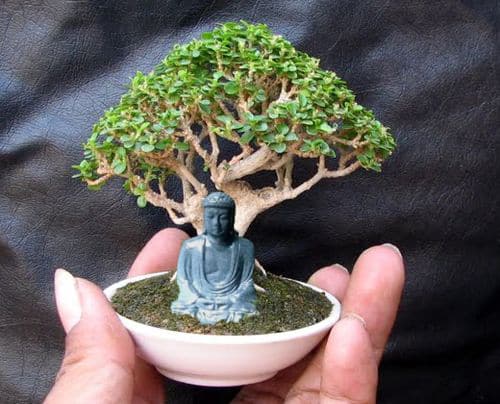Recent claims of ethical and environmental issues have caused concern within the bonsai community. This has lead to people have shunned bonsai, despite its ancient peaceful history. Many of the concerns are considered with best intentions, but they often lead to a great deal of misinformation. Here are some of the largest concerns regarding bonsai, and why they don’t need to be concerned at all.
Can Bonsai Trees Feel Pain?
Bonsai, and plants in general, cannot feel pain given their lack of brain and central nervous systems. While humans and animals evolved and developed pain sensors as a defense mechanism to avoid physical harm, this never happened with trees.
Some studies demonstrate that plants can feel certain sensations such as vibrations, but these sensations are never more than an acknowledgment. They are not something the tree deems painful. Nothing about bonsai is cruel and keeping them in a pot is not torturing the plant.
Stunting the Bonsai Tree is Cruel
One of the most noticeable properties of a bonsai is its size. Any tree can become a bonsai, so it’s possible to see California redwoods measuring inches high instead of hundreds of feet. This brings up the first major ethical concern for many people: Doesn’t keeping the tree stunted inherently harm the tree?
You may naturally be inclined to think this way. When we see children with stunted growth, it’s almost always caused by some form of malnutrition. For children, this means the child isn’t getting the proper nutrients. With trees, the principal is very much the same, but without the stigma of physical harm.
Does Pruning a Bonsai Hurt the Tree?

Another common ethical concern is pruning a bonsai plant, as many believe snipping off parts of the tree would cause the plant to feel pain in some way. However, pruning a bonsai tree doesn’t differ much from how a gardener would prune the flowers in their garden.
This is also true for bonsai. Removing the dead ends of a bonsai promotes healthy growth in the plant in addition to shaping the tree in the desired form. Just as there are no ethical concerns in getting your hair cut to remove dead or split ends, there are no moral concerns for trimming a bonsai’s branches to stimulate further, healthy growth.
Are Bonsai Wires Bad for the Enviroment?

Wrapping wires around roots and branches may seem like a torturous way to grow a tree, forcing something to grow in a way it wouldn’t naturally. However, that’s not entirely the purpose of wiring a bonsai’s branches and roots.
The wires used for shaping the tree are only used while the tree is young. They are adjusted and removed before they can dig into the bark and damage the tree.
Bonsai trees have a small root system, due to being grown in pots. This can make it difficult for the bonsai to stay upright, especially when the plant is young. To prevent bonsai trees from falling out of their pots, wires are tied attached to the tree and the sides of the pot. These support wires stabilize the bonsai tree until it’s stable enough to continue growing without assistance.
Wires in Gardening
We do this all the time with plants in our gardens; perhaps a string bean plant continues to grow upward but can’t without falling over. To support the plant’s growth, we place wire or wooden structures, which allow the plant to continue growing. Depending on the shape of the support structures, you can also influence the shape of your garden’s vines and vegetables without damaging your conscience.
Is Bonsai Wrong or Bad for the Enviroment?
Growing bonsai does not harm the environment in any way. These trees do not deprive other plants of resources or pollute. If anything, recreating nature within your home is beneficial to the environment.
The environmental concern is even less convincing when considering that wild bonsais do naturally occur. Natural bonsai grow when the soil and resources around it aren’t plentiful enough for a full tree to grow, thus stunting the tree.
Growing a Bonsai Tree vs a Natural Tree
Wild trees must adapt to the environment they’re in, which can mean spreading their roots over a vast area or deep within the ground depending on soil consistency and nutrients available. If there are blockades, such as a layer of bedrock that prevents the tree roots from delving deeper, the tree roots expand horizontally. Bonsai trees do not have such concerns. When you plant a bonsai tree, you do so in a small pot to promote small growth.
Gardeners frequently follow the same steps for a beginning blossom; the difference comes when the flower grows too large for the pot. Gardeners often want more or larger flowers, so the plant is moved from a small pot to a larger one. Because a bonsai remains in a small pot, the tree does not grow the root structure necessary to hold a large plant, and therefore the bonsai adapts to its pot just like a tree does to encountering bedrock.
Conclusion
Overall, bonsais are a stunning example of what nature can do if nudged in the right direction. The plant does not feel any pain during its growth; in fact, bonsais often live for several centuries whereas full-sized trees may not live half that long in the wild. Recent studies have also demonstrated the therapeutic benefits of growing and caring for bonsai, with one study categorizing bonsai art as “ecopsychological art therapy.” If cared for correctly, your bonsai will flourish alongside you.

